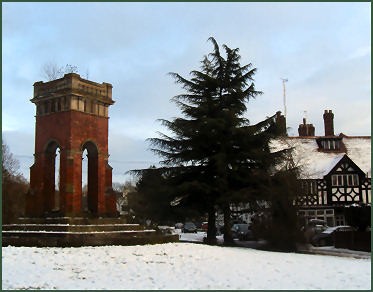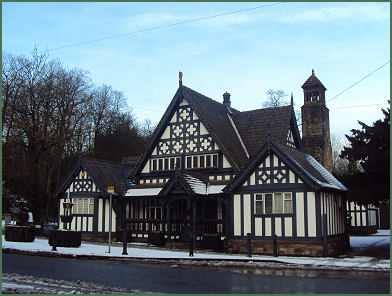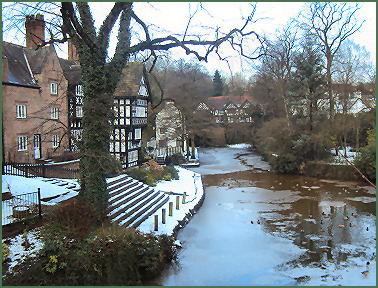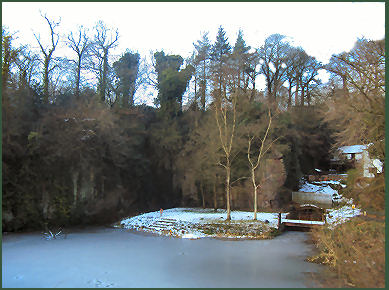Worsley
OS grid ref:- SD7401
The first recorded mention of Worsley occurs in a Pipe roll of 1195–96, where it is referred to as Werkesleia. There are many variations on the town's name; it is recorded as Wyrkedele in 1212; Whurkedeleye, in c. 1220; Worketley in 1254; Worcotesley in 1276; Workedeley, in 1292; and Wyrkeslegh in 1301. The spelling in early documents suggests an Anglo-Saxon origin. Ge-Weore, the Old English form of the name, means "the cleared place which was cultivated or settled."


In 1958 the head of a man was found by peat diggers on Worsley Moss, named "Worsley Man", and originally thought to be no more than 20 years old, upon the discovery of Lindow Man, it was re-examined and dated to approximately the 2nd century AD, in the Romano-British period. The head had a wound behind the right ear, fractures to the top of the skull, the left temple had been hit with a blunt object, causing bone splinters to enter his brain, there was also a cut through the vertebra where he had been decapitated. The remains of a garotte were also found around his neck, suggestive of a ritual killing. The condition of the tooth pulp suggested that Worsley Man was 20–30 years old at the time of his death, which radiocarbon dating of a fragment of preserved soft tissue indicated was during the late Iron Age, some time around 120 AD, identifying him as a Romano-British Celt. Worsley Man is now in the care of the Manchester Museum.
Worsley was once the largest of the seven ancient manors of the Bridgewater Estates. It was created by William the Conqueror and held by by a Norman knight named Elias, who fought in the crusades. On the death of Elias, the manor was inherited by his son, whose family had by that time taken the surname of Worsley. In the late fourteenth century their lands passed to the Massey family of Tatton and in the sixteenth century became the property of the Brereton family of Malpas. Richard Brereton later married Dorothy Egerton, and upon his death the estates passed into the Egerton family. In 1617 John Egerton became Earl of Bridgewater, he succeeded to the Worsley estates in 1639, and died in 1649. The title of Duke of Bridgewater was first given to John's descendant Scroop Egerton in 1720. His son, Francis Egerton, the third Duke of Bridgewater, built the Bridgewater Canal.
Worsley Court House and the Green


Coal has been mined in the Worsley for centuries, but with the onset of the Industrial Revolution and the growing use of steam power, there was a rapid increase in the demand for coal. The Duke of Bridgewater's mines supplied coal to the surrounding districts but transport was both inefficient and expensive, in addition the mines also often flooded. To resolve these problems he constructed the Bridgewater Canal from Worsley to Salford. James Brindley was brought in for his technical expertise and suggested varying the route of the proposed canal away from Salford and across the Irwell into Manchester, work commenced in September 1760 the canal opened in 1761.
Worsley Delph, now a scheduled monument, was the entrance to the Duke's underground mines. The underground canal was constructed from Worsley Delph, an old sandstone quarry near Worsley Brook. At one time a million tons of coal a year passed through this tunnel. To relieve congestion a second tunnel was constructed which met with the original about 500 yards in.The entrances allow access to 46 miles (74 km) of underground canal on four levels. Specially constucted boats were used to navigate the tunnels. They measured four and a half feet in width and had protruding ribbed sides which ked to them being given the nickname of "starvationers".
Worsley Village was in 1969 designated as a conservation area in 1969. The area has a large number of listed buildings, which include the Packet House and the Delph sluice gates. Much of the area around the canal and Worsley Delph was restored and landscaped between 1966 and 1967. As the canal passes through Worsley, iron oxide from the mines tints the water bright orange. The removal of this colouration is now the subject of a £2.5 million remedial scheme.
The Bridgewater Canal at Worsley and Worsley Delph


Worsley Green, an area of public open space, is bordered by terraces of attractive eighteenth century cottages and nineteenth century houses with elevations in black-and-white vernacular style. The Victorian ornamental fountain that stands on the Green, originally formed part of a chimney stack on factory buildings that stood on the site of Worsley Green. The principal buildings of interest in the village are the Bridgewater Estate Offices, the Nailmaker's House, Rock House, Packet House, Court House and former Police Station.
Wardley Hall, an early medieval manor house dates from around 1500 but was extensively rebuilt in the nineteenth and twentieth centuries. Worsley Old Hall is a Grade II listed building near Walkden Road. The building is said to have been moated, but no signs of the moat remain today.
Parts of Worsley are currently being considered as World Heritage Sites. The area includes Worsley Delph, parts of Worsley Green, and the Bridgewater Canal.
